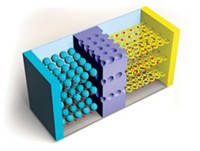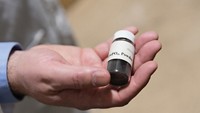Advertisement
Grab your lab coat. Let's get started
Welcome!
Welcome!
Create an account below to get 6 C&EN articles per month, receive newsletters and more - all free.
It seems this is your first time logging in online. Please enter the following information to continue.
As an ACS member you automatically get access to this site. All we need is few more details to create your reading experience.
Not you? Sign in with a different account.
Not you? Sign in with a different account.
ERROR 1
ERROR 1
ERROR 2
ERROR 2
ERROR 2
ERROR 2
ERROR 2
Password and Confirm password must match.
If you have an ACS member number, please enter it here so we can link this account to your membership. (optional)
ERROR 2
ACS values your privacy. By submitting your information, you are gaining access to C&EN and subscribing to our weekly newsletter. We use the information you provide to make your reading experience better, and we will never sell your data to third party members.
Energy Storage
Movers And Shakers
Battery expert Dame Clare Grey’s pioneering studies could lead to a more sustainable energy future
University of Cambridge professor is winner of the 2022 ACS Central Science Disruptors and Innovators Prize
by Neil Savage, special to C&EN
September 6, 2022
| A version of this story appeared in
Volume 100, Issue 32

Clare P. Grey of the University of Cambridge is this year’s recipient of the ACS Central Science Disruptors and Innovators Prize. The award honors a scientist who has made a paradigm-shifting breakthrough of broad relevance. Grey, a materials chemist, received the award “in recognition of her extensive and disruptive research” applying solid-state nuclear magnetic resonance spectroscopy to materials relevant to energy and the environment. Her work has paved the way for less-expensive, longer-lasting batteries by revealing some of the mechanisms that cause rechargeable batteries, particularly lithium-ion devices, to degrade. Her work has also helped improve storage systems for renewable energy.
Grey, who is also a professor at Stony Brook University, spent 2 years as a visiting scientist at DuPont in the early 1990s studying alternatives to the chlorofluorocarbons that harm Earth’s ozone layer. She is chief scientist and cofounder of Nyobolt, a company that is developing ultrafast-charging batteries for electric vehicles. Neil Savage spoke with her about her work on energy storage materials and why she believes they are important to the future of the planet.
This interview was edited for length and clarity.
Vitals
▸ Current positions: Geoffrey Moorhouse Gibson Professor of Chemistry, University of Cambridge; adjunct professor of chemistry, Stony Brook University; director, Engineering and Physical Sciences Research Council Centre of Advanced Materials for Integrated Energy Systems
▸ Education: BA, chemistry, 1987, and DPhil, chemistry, 1991, University of Oxford
▸ Recent award besides the ACS Central Science Disruptors and Innovators Prize: ACS Central Science Disruptors and Innovators Prize The 2021 Körber European Science Prize, worth €1 million ($1.07 million)
▸ Hobbies: Playing cello in an orchestra and cross-country skiing
What is it about batteries that appeals to you?
I’m very interested in the role that batteries play in climate change. If we can develop cheaper batteries for grid-scale applications, that can have tremendous impact. For cars and general electrification, we again need cheaper, safer batteries. So I’m interested in that broader picture. From a more fundamental perspective, what’s nice about it is there’s some really interesting questions that need to be answered. Even though batteries have been around for a long time, there are still a lot of things we don’t understand and lots of fundamental physics and chemistry questions.
What is the main focus of your work?
I’m interested in how the environments around atoms impact the way they behave. I’ve spent most of my career working on lithium-ion batteries, particularly using NMR spectroscopy to look at what the local environments around the lithiums are. It’s a probe of local structure. You can use the method to look at the oxidation states of the metals in battery cathode materials and how they change as you cycle the cathode materials—in other words, as you pull lithium out of the structure during charging.
More recently, I’ve moved on to the next generation of technologies. That might be sodium-ion batteries or magnesium batteries or lithium-air batteries. So what we’ve done is push the use of NMR spectroscopy to get new information about the functioning of batteries.
How did you start using NMR to study batteries?
My adviser, professor Tony Cheetham at Oxford, was inspired to push this method into new areas. I had a second supervisor, Chris Dobson, who had just bought a solid-state NMR spectrometer, and together they’d worked on trying to increase the applications where solid-state NMR spectroscopy could be used. I was just excited by doing something different. I liked structural complexity, and I liked the fact that it was new. I liked the combination of not just making things but interpreting them and that equipment-intensive, analytical part of it. Also, I got interested in environmental questions and broad-impact science.
What are some of the big questions still outstanding about batteries?
The biggest question is, How can we make a much cheaper battery? One way to reduce cost is to make batteries that don’t degrade as much and last longer. How do we make a battery where we’ve removed most of the cobalt so that it’s much more sustainable and still get it to work? How do we devise batteries that may not look like batteries we think of right now but that really will make an impact on grid storage? If we’re going to move to an economy that will be largely wind and solar, how do we deal with the intermittency?
The war in Ukraine has also highlighted issues of energy security, and people are much more aware of the whole issue of sourcing and where things come from.
Why are you focusing on fast-charging batteries for cars with Nyobolt?
Because people are used to being able to drive 300 or 400 mi [480 or 640 km] on a tank of gas, they think that’s what they want. As a result, you have to have these monster batteries. And in terms of sustainability, they’re terrible because of the resources that go into them. They’re also expensive. What we would like to do is have batteries that can charge faster so you know that even if you run out, you can charge so quickly that you just rethink your way of operating. In point of fact, most people don’t need 300, 400 mi. Even with long daily commutes in the US, that’s still a week of driving for most people.
Batteries are currently the best energy storage system we have for automobiles. Until we come up with other energy vectors, they are the solutions that we have to operate with. One of the duties we have is to think about which vectors would be less harmful for the environment if we’re going to meet the Paris Agreement’s 2050 goal of net-zero carbon emissions.

Neil Savage is a freelance writer based in Massachusetts who covers chemistry, computing, and photonics. A version of this story first appeared in ACS Central Science: cenm.ag/grey.
To learn more, watch Clare Grey’s talk on Sept. 20 as part of C&EN’s Talented 12 virtual event. Register at cenm.ag/t12symposium





Join the conversation
Contact the reporter
Submit a Letter to the Editor for publication
Engage with us on Twitter